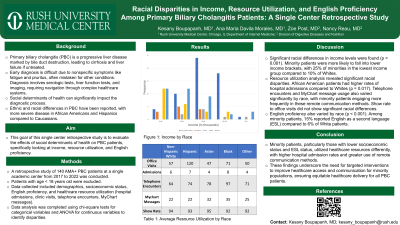Tuesday Poster Session
Category: Biliary/Pancreas
P3444 - Racial Disparities in Income, Resource Utilization, and English Proficiency Among Primary Biliary Cholangitis Patients: A Single Center Retrospective Study
Tuesday, October 29, 2024
10:30 AM - 4:00 PM ET
Location: Exhibit Hall E

Has Audio

Kesany Boupapanh, MD
Rush University Medical Center
Chicago, IL
Presenting Author(s)
Kesany Boupapanh, MD1, Ana Maria Davila Morales, MD2, Zoë Post, MD1, Nancy Reau, MD1
1Rush University Medical Center, Chicago, IL; 2Rush University, Chicago, IL
Introduction: Primary biliary cholangitis (PBC) is a progressive liver disease that can lead to cirrhosis and liver failure. Early diagnosis is difficult due to nonspecific symptoms like fatigue and pruritus. Diagnosis requires serologic tests, liver function tests, and imaging. Social determinants of health can impact the diagnostic process. This study evaluates the effects of social determinants on PBC patients.
Methods: A retrospective study of 140 AMA+ PBC patients at a single academic center from 2017 to 2022 was conducted. Data included demographics, socioeconomic status, English proficiency, and healthcare resource utilization. Statistical analyses used chi-square tests for categorical variables and ANOVA for continuous variables to identify disparities.
Results: Among the 140 PBC patients, 90% were female. The racial composition was 49.3% White, 17.1% Black, 5.7% Asian, 27.1% Other, and 0.7% American Indian, with 30.7% identifying as Hispanic or Latino. Minorities made up 50.7% of the cohort. Significant racial differences in income levels were found (p < 0.001). Minority patients were more likely to be in lower income brackets, with 25% of minorities in the lowest income group compared to 10% of Whites. Median income for minority patients was significantly lower than for White patients.
Resource utilization analysis revealed significant racial disparities. African American patients had higher hospital admission rates compared to Whites (p = 0.017). Telephone encounters and MyChart message usage also varied significantly by race, with minority patients using these remote communication methods more frequently. Clinic visit frequency did not show significant racial differences. Diagnosis delays were evident for AMA (p = 0.044) and TB (p = 0.026) by race. English proficiency varied by race (p < 0.001), with 15% of minority patients reporting English as a second language (ESL) compared to 6% of White patients.
Discussion: This study highlights significant racial disparities in income, healthcare resource utilization, and English proficiency among PBC patients. Minority patients, particularly those with lower socioeconomic status and ESL status, had higher hospital admission rates and greater use of remote communication methods. These findings underscore the need for targeted interventions to improve healthcare access and communication for minority populations by addressing socioeconomic barriers and enhancing language support services.
Disclosures:
Kesany Boupapanh, MD1, Ana Maria Davila Morales, MD2, Zoë Post, MD1, Nancy Reau, MD1. P3444 - Racial Disparities in Income, Resource Utilization, and English Proficiency Among Primary Biliary Cholangitis Patients: A Single Center Retrospective Study, ACG 2024 Annual Scientific Meeting Abstracts. Philadelphia, PA: American College of Gastroenterology.
1Rush University Medical Center, Chicago, IL; 2Rush University, Chicago, IL
Introduction: Primary biliary cholangitis (PBC) is a progressive liver disease that can lead to cirrhosis and liver failure. Early diagnosis is difficult due to nonspecific symptoms like fatigue and pruritus. Diagnosis requires serologic tests, liver function tests, and imaging. Social determinants of health can impact the diagnostic process. This study evaluates the effects of social determinants on PBC patients.
Methods: A retrospective study of 140 AMA+ PBC patients at a single academic center from 2017 to 2022 was conducted. Data included demographics, socioeconomic status, English proficiency, and healthcare resource utilization. Statistical analyses used chi-square tests for categorical variables and ANOVA for continuous variables to identify disparities.
Results: Among the 140 PBC patients, 90% were female. The racial composition was 49.3% White, 17.1% Black, 5.7% Asian, 27.1% Other, and 0.7% American Indian, with 30.7% identifying as Hispanic or Latino. Minorities made up 50.7% of the cohort. Significant racial differences in income levels were found (p < 0.001). Minority patients were more likely to be in lower income brackets, with 25% of minorities in the lowest income group compared to 10% of Whites. Median income for minority patients was significantly lower than for White patients.
Resource utilization analysis revealed significant racial disparities. African American patients had higher hospital admission rates compared to Whites (p = 0.017). Telephone encounters and MyChart message usage also varied significantly by race, with minority patients using these remote communication methods more frequently. Clinic visit frequency did not show significant racial differences. Diagnosis delays were evident for AMA (p = 0.044) and TB (p = 0.026) by race. English proficiency varied by race (p < 0.001), with 15% of minority patients reporting English as a second language (ESL) compared to 6% of White patients.
Discussion: This study highlights significant racial disparities in income, healthcare resource utilization, and English proficiency among PBC patients. Minority patients, particularly those with lower socioeconomic status and ESL status, had higher hospital admission rates and greater use of remote communication methods. These findings underscore the need for targeted interventions to improve healthcare access and communication for minority populations by addressing socioeconomic barriers and enhancing language support services.
Disclosures:
Kesany Boupapanh indicated no relevant financial relationships.
Ana Maria Davila Morales indicated no relevant financial relationships.
Zoë Post indicated no relevant financial relationships.
Nancy Reau: AbbVie – Grant/Research Support. Arbutus – Advisor or Review Panel Member. Gilead – Advisor or Review Panel Member, Consultant, Grant/Research Support. Salix – Advisor or Review Panel Member, Grant/Research Support. VIR – Advisor or Review Panel Member.
Kesany Boupapanh, MD1, Ana Maria Davila Morales, MD2, Zoë Post, MD1, Nancy Reau, MD1. P3444 - Racial Disparities in Income, Resource Utilization, and English Proficiency Among Primary Biliary Cholangitis Patients: A Single Center Retrospective Study, ACG 2024 Annual Scientific Meeting Abstracts. Philadelphia, PA: American College of Gastroenterology.
